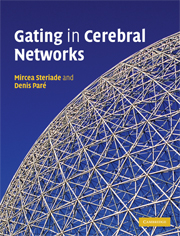
-
Select format
-
- Publisher:
- Cambridge University Press
- Publication date:
- August 2009
- September 2007
- ISBN:
- 9780511541735
- 9780521851220
- Dimensions:
- (246 x 189 mm)
- Weight & Pages:
- 0.912kg, 342 Pages
- Dimensions:
- Weight & Pages:
- Subjects:
- Life Sciences, Neurosciences
You may already have access via personal or institutional login- Subjects:
- Life Sciences, Neurosciences
Book description
The correct functioning of the mammalian brain depends on the integrated activity of myriad neuronal and non-neuronal cells. Discrete areas serve discrete functions, and dispersed or distributed communities of cells serve others. Throughout, these networks of activity are under the control of neuromodulatory systems. One goal of current neuroscientific research is to elucidate the precise methods by which these systems operate, especially during normal conscious behaviours and processes. Mircea Steriade and Denis Paré describe the neuronal properties and networks that exist within and between the cortex and two important sub-cortical structures: the thalamus and amygdala. The authors explore the changes in these properties, covering topics including morphology, electrophysiology, architecture and gating; and comparing regions and systems in both normal and diseased states. Aimed at graduates and postdoctoral researchers in neuroscience.
Contents
Metrics
Full text views
Full text views help Loading metrics...
Loading metrics...
* Views captured on Cambridge Core between #date#. This data will be updated every 24 hours.
Usage data cannot currently be displayed.
Accessibility standard: Unknown
Why this information is here
This section outlines the accessibility features of this content - including support for screen readers, full keyboard navigation and high-contrast display options. This may not be relevant for you.
Accessibility Information
Accessibility compliance for the PDF of this book is currently unknown and may be updated in the future.


